冀教版七年级英语下册Lesson_1_a_trip_to__China课件
(精品)2013新冀教版七年级英语下册lesson_1_a_trip_to_China课件

Is the Silk Road made of silk?
be made of 由……制成(看出原材料) The kite is made of paper. be made from由……制成(看不出原材料) The paper is made from wood.
长时间的旅行、国外旅行”. He is travelling in Africa.
Part 4
❖break [breɪk] v. 打破;弄坏; n. 破裂;中断,休息
❖join [dʒɔɪn] ]vt.& vi.加入;参加 ❖study ['stʌdɪ] ]n.学习,研究;书房; ❖truly ['tru:lɪ] adv.真正; 正确地;忠实的
一般将来时
时间状语:tomorrow, next week/month 陈述句:主语+will+动词原形+…
主语(I /we)+will/shall+v+… ❖否定句:主语+won’t /shan’t+v+… ❖一般凝问句:Will +主语+v+…? ❖You will learn about China. ❖You will not/won’t learn about China. ❖Will I learn about China? ❖Yes, you will. / No, you won’t.
❖Sending letters is not popular now. But you can send gifts or e-mails to others.
最新冀教版七年级英语下册:Lesson1:A_Trip_to_China

冀教版七年级下册Lesson 1:A Trip to China一、教材分析1. 教学目标●语言知识(1)掌握词汇:trip,silk,road,lead,note,chance,send,news(2)短语及句型:guess what,learn about●语言技能能够用英语谈论旅游的话题。
●情感态度培养学生有兴趣说英语,积极参与课堂活动,大胆发言,敢于用英语谈论自己的旅行经历●学习策略积极运用所学英语进行表达和交流,2. 教学重点本课掌握的词汇与句型3.教学难点learn about ,send ,plan(动词和名词的用法区别)二、教学准备多媒体、图片英汉字典三、教学步骤Step I Class Opening (5 minutes)1.Warm up2.ReviewAsk the class to list,some examples of when they might use “May I...?”and they should respond to those questions。
Examples:May I borrow your book?May I go with me?May I watch TV?Response:Yes,you may.\ No,you may not。
Step II New Concepts (40 minutes)1.Learn some new words2.Present: Tell the students that today they will learn how to ask for permission and how to use the word “will”to express something that is going to happen or something you want to in the future.For example: “I am standing. I will sit later.”Ask the class to give some more examples.3.Listen: Let’s Do It! No.1.(1)Play the tape for Lesson 1(Play it once and ask the students to listen.)(2)Discuss the answers to Let’s Do It!(3)Play the tape for Lesson 1 a second time and have the class read aloud along with the tape.4.Review what was learned. Ask the class to point out the“May I ... ?”and “will”sentences in the lesson.5.Group work:(1)Have the class read and answer the questions in Let’s Do It! No.2.(2))Discuss the answers to Let’s Do It! No.2.6. Practice and playPractice asking for permission using the new vocabulary words.7.Pair work: Ask the students to look at Let’s Do It! No.3. and find the Chinese meaning for each word in the box.(Every group of students have an English-Chinese dictionary to complete this task.8.Read the dialogue and find out language points.9.Do exercise.10. Task(1) Read Let’s Do It! No.4. Split the students in groups to complete the task.(2) Choose some groups to present one of their dialogues in front of the class.Step III Class ClosingHomework1. Review and recite the important points of Lesson 1.2. Try to write a note asking for permission to go on the trip.3. Preview Lesson 2.板书设计Lesson 1Language points:1)guess what May I watch TV?2)learn about Yes,you may.\ No,you may not。
2020版七年级英语下册Unit1ATriptotheSilkRoadLesson1ATriptoChina课件(新版)冀教版
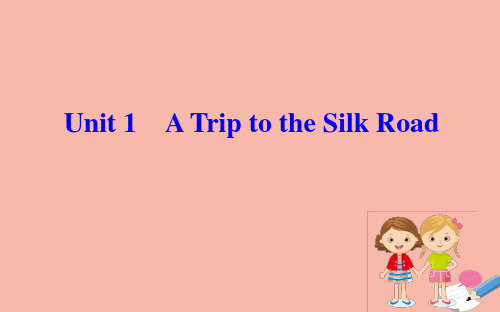
肯定 Yes, you may/can. 回答 Yes, please.
Sure/Certainly/ Of course. 否定 No, you can’t. 回答 Sorry, you can’t.
You’ d better not.
Step 3 考点·练 ( D )①(2019·宿迁中考)—Mum, may I go to see a film with my cousin? —You ________go if you have finished your homework. A. must B. need C. should D. can
5. 学习; 了解 _le_a_r_n_a_b__o_u_t
6. 由……制成 _b_e_m__a_d_e_o_f_
7. 有机会做
_h_a_v_e_a__c_h_a_n_c_e_t_o_d__o_. _. _. _
8. 寄给某人某物 _s_en__d_s_b_._s_th__. _/s_e_n_d__st_h_.__to__s_b_.
【拓展】 lead的名词形式leader 意为“领导者; 领袖” Chairman Mao was a very great leader. 毛主席是一个非常伟大领袖。
Step 4 考点·练 ①Mr Li often _le_a_d_s_ us to the park to have a picnic. ②这条小路通向一个村庄。 This path _le_a_d_s_ _to_ a village. ③张老师将会带领这个小组去北京。 Mr Zhang _w_i_l_l _le_a_d_ the group _to_ Beijing.
Ⅲ. Read the dialogue and answer the questions. 1. What’s Jenny learning about this month in school? _S_h_e_i_s_l_e_a_rn__in_g__a_b_o_u_t_t_h_e_S_i_l_k_R__o_a_d_(_t_h_is_m__o_n_t_h__in_ _s_ch__o_o_l)_. _
七年级英语下册 Unit 1 Lesson 1 A Trip to China课件2 (新版)冀教版

Task 1 Make up a dialogue
Task 2
Write a note
Task 1
• A: Hi! Guess what! We’re learning about…
• May I go …?
• B: Who will lead the trip?
• A: … Here is the note from my school.
DEAR PARENTS,
WE ARE PLANNTINheGnAotTeRfrIoPmTO CHINA DURING THE MARCH BsRcEhAooKl.
WE WILL JOIN OUR SISTER SCHOOL IN CHINA ON A TRIP TO THE SILK ROAD. ALL STUDENTS IN GRADE 7 ARE INVITED. MS. MARTIN WILL TRAVEL WITH THE STUDENTS. HER CLASS IS DOING A CHINA STUDY THIS TERM. THE GROUP WILL LEAVE ON MARCH 5 AND COME BACK ON MARCH 15. FOR MORE INFORMATION, PLEASE COME TO THE MEETING ON WEDNESDAY AT 7 P.M. YOURS TRULY, MR. BRIAN FRANKLIN
• Because Jenny wants to tell him the
good news.
We can get some news from him.
• 3. How does Jenny ask her parents’ permission(允许) to China?
新冀教版七年级英语下册Unit1 A Trip to China Lesson 4 A Visit to Lanzhou精品课件(共26张PPT)
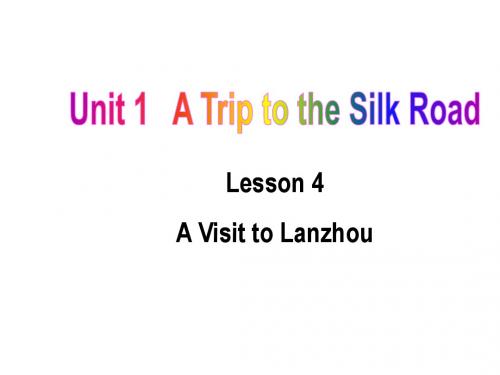
p9
Answer the following questions. 1. How long is the Yellow River? It is about 5 400 kilometres long. 2. What do Chinese people call the Yellow River? The Mother River. 3. Where does the group see the Mother River Statue? Beside the Yellow River. 4. What do the children say when Ms. Martin takes their picture? Cheese!
Fill in the blanks. The group takes a train to Lanzhou. Then go for a walk they go to the hotel. Later they ___________ along the Yellow River. The Lanzhou Zhongshan Bridge was the first bridge over the Yellow River. The Silk Road _______ crossed the Yellow River in Lanzhou. The ________ wide and long. It is called the Yellow River is _____ Mother River. The statue beside the Yellow River is the Mother River statue. They can take a picture in front of the statue. ______________
Unit 1 Lesson 1 A Trip to China【课件】七年级英语下册(冀教版)

Ask for permission
A: May I / we …? B: Yes, you may. / Yes, please.
/ Yes, of course. / Sure. No, you may not. / No, you can’t. / No, please don’t. / No, you mustn’t. / No, you’d better not.
1. The path goes through the woods and leads to the village. 这条小路穿过树林,通往村庄。
2. Mr. White leads us to visit the beautiful park. White先生带领我们参观这个漂亮的公园。
Learning point 2. Who will lead the trip?
The paper is made ______wood and the desk is also made______wood. A. of; from B. of; of C. from; of D. from;from
Read and Fill
lead trip chance news travel note
trip n. 旅行,旅程 trip通常指时间较短、距离较近的旅行,旅行方式不变, 并且意味着旅行结束后还要回到原来的地方。 trip的常见搭配: a trip to ... 一次去...的旅行 go on a trip to ... 去...旅行
1. Have a nice trip! 旅途愉快! 2. May we go on a trip to Canada? 我们可以去加拿大旅行吗?
Summary
冀教版英语七年级下册Unit 1:Lesson 1 A trip to China. 教案设计

Pair work Cooperative study
课前
预习
Preview the new words and phrases.
Let’s do it No2. and No3.
教学过程
教学环节
教学内容
教师活动
学生活动
批注
Step1:
Presentaion
/discussion
1.What day is it today?
Step4
Reading
Part2
1. What does Mrs.Smith think about the trip?
2. Why will Jenny send Li Ming an e-mail??
1. Give tasks .
2. Check the answers
3. Write language points on the blackboard
4. Teach and practice.
1. Read after the tape.
2. Discuss and find out the answers.
3. Answer.
4. Practise.
5. Finish Number1and2 in Let’s Do It.
6. keep notes
2. Be able to use the future tense freely.
情感态度与价值观:
1. Let them learn about talking about their trips freely.
2. Let them know more about the places of interest, In this way to enpower their talking ability in English.
冀教版七年级英语下册《A Trip to China》PPT课件(4篇)

Lesson 1 A Trip to China
●3 send v. 寄;送
[观察] I will send Li Ming an email and tell him the good news. 我要给李明发一封电子邮件,告诉他这个好消息。 Tom sends a letter to me every week. 汤姆每周给我寄一封信。 [探究] (1)send后面常搭配postcard, present等词,表示 “寄(明信片、礼物等)”。 (2)send sb. sth.=send sth. __t_o_ sb.,意为“给某人寄某 物”。
Unit 1 A Trip to the Silk Road
A Trip to China
Lesson 1 A Trip to China
课前自主预习
单 1. 旅行,旅程 [trɪp] n. _t_ri_p_____ 词 2.丝;丝绸 [sɪlk] n. __s_ilk_____ 闯 3.路,公路 [rəʊd] n. _r_o_a_d____ 关 4.带领;指路 [liːd] v. _l_e_ad_____
Lesson 1 A Trip to China
2.(1)这条小路通向一个村庄。 This path _le_a_d_s____ ____t_o___ a village. (2)张老师将会带领这个小组去北京。 Mr. Zhang w__il_l _____ _l_e_a_d___the group ____t_o___ Beijing.
Lesson 1 A Trip to China
活学活用 1.你想去西藏旅行吗? Do you want to _h_a_v_e_/_ta_k_e_ _____a___ ____t_r_ip__ ______to___ Tibet?
冀教初中英语七下《Lesson 1 A Trip to China》PPT课件

Unit 1 A Trip to the Silk Road
Lesson 1 A Trip to China
Lead-in
Free Talk
How was your winter holiday? Do you like travelling? Where do you want to travel?
Language Points
1. May I go with them? 我可以和他们去吗?
may 是情态动词,表示允许或征询对方的 许可,其否定形式可以是 may not ,也可以是 must not / mustn’t;但表示禁止时常用 must not/mustn’t。例如: —May I go to the cinema?——我可以去看电影吗? —Yes, you may. / Not, you mustn’t. ——是的,你可以去。/ 不,你不可以去。 注意:表示客气请求或征询意见时,也可用 Can I/Could I/Could you…?句型来表达。例如: Can I help you?要我帮忙吗? Could you help me, please? 你能帮我一下吗?
2. I will send Li Ming an e-mail and tell him the good news. 我会给李明发个电子邮件,并且告诉他这个好消息。
1)send sb. sth.=send sth. to sb. 给某人寄某物。例如: He oftey. 他常给父亲寄钱。 2)news,不可数名词。可用some, much来修饰,一条 消息可说成a piece of news。
强兵是打出来的。没有天生的信心,只有不断培养的信心。没有一种不通过蔑视、忍受和奋斗就可以征服的命运。 3、懂得低头,才能出头。懦弱的人只会裹足不前,莽撞的人只能引为烧身,只有真正勇敢的人才能所向披靡。我们这个世
冀教版英语七下Unit1《Lesson1ATriptoChina》精品说课稿

冀教版英语七下Unit 1《Lesson 1 A Trip to China》精品说课稿一. 教材分析冀教版英语七下Unit 1《Lesson 1 A Trip to China》是一篇介绍中国旅游景点的阅读文章。
通过讲述一位美国学生在中国旅游的经历,让学生了解中国的自然风光和文化遗产,提高他们的英语阅读能力。
教材内容丰富,插图精美,激发学生学习兴趣。
二. 学情分析七年级学生已具备一定的英语基础,对日常生活和简单的人文知识有所了解。
但他们在阅读长篇阅读材料时,可能会遇到生词和语法难点。
因此,在教学过程中,需要关注学生的个体差异,调动他们的学习积极性,帮助他们克服学习困难。
三. 说教学目标1.知识目标:让学生掌握文章中的关键词汇和语法知识,提高阅读理解能力。
2.能力目标:培养学生的英语听说能力,使他们在日常生活中能运用所学知识进行交流。
3.情感目标:激发学生对中华文化的兴趣,增强他们的民族自豪感。
四. 说教学重难点1.重点:文章中的关键词汇和语法知识。
2.难点:理解文章内容,运用所学知识进行实际交流。
五. 说教学方法与手段1.交际法:通过小组讨论、角色扮演等形式,让学生在实际语境中运用英语。
2.情境教学法:利用图片、视频等资源,创设生动直观的学习情境。
3.任务型教学法:引导学生参与各种实践活动,提高他们的综合语言运用能力。
六. 说教学过程1.导入:展示中国旅游景点的图片,引导学生谈论自己喜欢的景点,激发学习兴趣。
2.阅读理解:让学生阅读文章,回答相关问题,检测他们对文章内容的理解。
3.词汇学习:讲解文章中的关键词汇和语法知识,让学生进行实际操作,巩固所学。
4.口语练习:分组进行角色扮演,让学生将所学知识运用到实际交流中。
5.听力训练:播放与文章相关的听力材料,提高学生的听力水平。
6.写作练习:让学生根据文章内容,写一篇关于中国旅游景点的短文。
7.总结与拓展:对本节课所学内容进行总结,引导学生进一步了解中国文化。
冀教版七年级下Unit1 A Trip to China Numerals课件
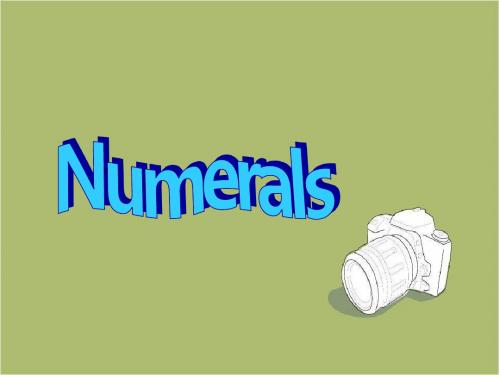
②“几十”的复数形式可以表示: 几十多岁 — in + one’s + 数词复数 年 代 — in + the +数词复数 He died in his forties. In the nineties, most people go to work by bike ③“基数词+名词” 的合成形容词作定语, 中间 有连字符“-”,当中的名词用单数。 a 3 – year – old girl a seven-day holiday ④表计量— “基数词+度量单位+形容词” The classroom is 7 meters long, 6 meters wide and 3 meters high.
5. We’ll have a ___ holiday. What about going to the West Lake? (2011上海) A. two days B. two—day C. two—days D. two—days’ 6. —How many teachers are there in your school? — ___, but I’m not sure. (2011江西) A. Hundreds B. Hundred C. Hundreds of D. One hundred
Objectives
1. 基数词 2. 序数词
语法讲解建议采用归纳法,如尽 可能多的呈现一些相关例句,或 可让学生从已学课文中找相应例 句,引导学生试着从所观察到的 语言现象中总结出语言规则和语 法规律。
1) It’s about 1114 kilometres. 2) The Silk Road is about 6500 kilometres. 3) It is about 12 kilometres long and over 600 years old. 4) It is over 1300 years old. 5) They are over 2000 years old. 6) The Yellow River is about 5400 kilometres long. 7) It is about 6300 kilometres long and over 2000 years old.
冀教初中英语七下《Lesson 1 A Trip to China》PPT课件

Ⅱ. 句型展示 1. 这个月我们在学校正在学习丝绸之路。 We’re________________theSilkRoadthismonth________schoo l. 2.——我可以问你一个问题吗?——当然可以! —________I________youaquestion? —________! 3. 这是我的学校的邀请函。 Here________the________frommyschool. 答案:1. learningabout; in2. May; ask; Sure 3. is; note
2. Whowillleadthetrip? 谁将带领这次旅行呢? 【自主领悟】 lead作动词,意为“带领;指路”, 后接名词作宾语,过去式 是led, 过adto引向;通向 例如:AllroadsleadtoRome. 条条大道通罗马。 (2)leadsb. tosp. 把某人领向某地 例如:Thegirlleadsustoanoldhouse. 这个小女孩把我们领到了一所老房子。
C. believingD. tobelieve
Ⅱ. 单项填空 1. Tomwillgoon________toChinanextWednesday. A. tripB. atripC. travelD. journey 2.—________Iaskyouaquestion?—Sure, please. A. MayB. WouldC. DoD. Will 3. Pleasesend________bestwishestoMary. A. IB. meC. myD. mine
1.—MayIaskyouaquestion? 我可以问你一个问题吗? —Sure!当然可以! 【自主领悟】 MayI...? 是请求对方许可或征求对方意见的交际用语,may为 情态动词,后跟实义动词原形,没有人称和数的变化。在口 语中常用can代替may,其肯定回答为:Yes, youmay. /Sure. /Ofcourse. /OK. 否定回答为:No, youmaynot.
冀教版七年级下册Lesson1ATriptoChina

He plans to visit his uncle next month.
I want to send my mother a letter. Language points
take/make notes 记笔记
带领 ,指路 过去式 led
May I borrow your bike, please?
learn v. 学习 过去式 learned/ learnt learn about 获得,了解,学到 learn from 从…学到; 向…学习 例句: 上星期学生们学习了中国历史。
The students learned about Chinese history last week.
3.May I ask you a question?
Every student should make notes carefully.
每个学生都应该认真做笔记。
5. lead v. 带领 ,指路 过去式 led lead …to 把…带到…
例句: 谁将带领这次旅行?
Who will lead the trip?
我将带你到等候室 I will lead you to the waiting room.
May I go to the park?
4. Here is the note from my school. 倒装句 note n. 笔记,便条 leave sb. a note 给某人留个便条 make/ take notes 做笔记
我能给杰克留个便条吗?
Can I leave Jack a note?
我能给杰克留个便条吗? make/ take notes 做笔记 例句: 让我们为聚会制定一个计划。
冀教版七年级英语下册 Unit1 Lesson 1 A Trip to China 复习课件

一、根据句意及首字母提示完成单词 1.We'll go on a t__________ to the Silk Road. rip
2.There is a piece of good n__________ on the Internet today. ews
3.Mr. Li often l__________us to the park to have a picnic. eads 4.It's a good c__________ for me to learn English. hance 5.Leave a n__________ for your parents when you go out alone. ote
我想给我的妈妈寄一封信。
当间接宾语sb.为代词时,需要用其宾格形式。 【易错点】 eg: I sent him an email.我给他发了一封邮件。 拓展 与send用法类似,可以接双宾语的动词还有give, show, pass, lend, tell等。 eg: Show me your tickets,please.
【解析】词语辨析法。news新闻,不可数名词,侧重一个 “新”字;message消息,一般指口头或书写的“消息”,
可数名词;situation情况;information信息,通常指在阅
读、观察、谈话或书信往来中特别关注的消息、情报、资 料等。在此强调新闻性。
14.Liu Mei has a chance __________Hainan. C A.visit C.to visit railway. A.send;for C.show;to B.send;to D.show;for B.trip D.Travel
冀教版七年级下Unit1 A Trip to China Lesson3 A Visit to Xian课件
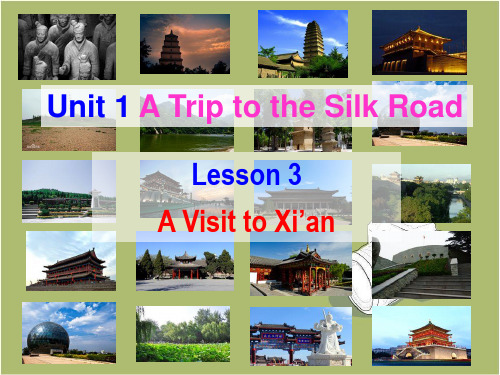
Words bell enjoy dish tour guide pit move sign n. 钟;铃 v. 喜欢;享受…….乐趣 n. 菜肴;盘,碟 n. & v. 旅游;游行 n. 导游;向导 n. 坑,深坑;陷阱 v. 移动;搬动 n. 招牌;记号
Objectives:
1. To know about some famous sights in Xi’an 2. To learn some key words and useful expressions 3. To learn to introduce some places of interest
(biangbiang面)
油泼辣子biangbiang面
biángbiang面是陕西关中民间传统风味面食,特指关中 麦子磨成的面粉,通常手工拉成长宽厚的面条。
Pita Bread Soaked in Lamb Soup
牛羊肉泡馍是西安市著名小吃,用优质牛羊肉 加佐料入锅煮烂,汤汁备用。把烙好的“虎背 菊花心”——坨坨馍,掰成碎块,加辅料煮制 而成。其特点是:肉烂汤浓、香醇味美、粘绵 韧滑。
p7
1
Listen and choose.
What can you see in Xi’an? Temple of Heaven The Big Wild Goose Pagoda The Drum Tower Mogao Grottoes The Bell Tower Terra Cotta Warriors
Words: hit, ancient, drum, ring, bell, enjoy, dish, tour, guide, move, sign
Phrases: climb up,
冀教版七年级下册英语 Lesson 1 A Trip to China 精品教学课件
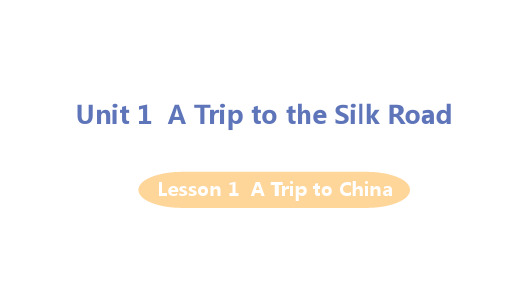
新课讲解 4 Work in groups. Read the note from Jenny’s school and take turns asking for permission to go on the trip.
新课讲解
back on March 15. For more information, please come to the meeting on Wednesday at 7 p.m. Yours truly, Mr. Brian Franklin
Task tips:What do you want to do?Where/When do you want to go? Who will you go with?
Silk Road gets its name from the Chinese silk trade along it during the Han Dynasty.
新课讲解
Language point 1
Who will lead the trip?
lead v.带领;指路 过去式为led,过去分词为led。
=I want to send a letter to my mother. 我想给我的妈妈寄一封信。
新课讲解
Language point 4
news /njuːz/n.新闻,消息 news为不可数名词。 e.g. No news is good news. 没有消息就是好消息。(谚语)
“一则新闻”应表达为a piece of news;“两则 新闻”为two pieces of news。
冀教初中英语七下《Lesson 1 A Trip to China》PPT课件 (3)
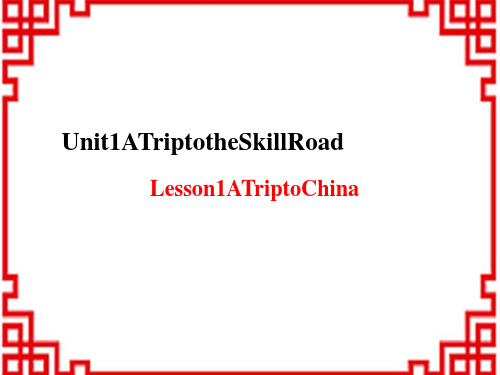
dthismonthinschool.
•2.
•F
LiMing’sschoolisplanningatripto
Canada.
•T
•3. Ms.
•2 •Readthedialogueinthelessonandanswerthe questions.
•1. WhatisJenny’sschoolplanning? •HerschoolisplanningatriparoundCh inawithLiMing’sschool.
Unit1ATriptotheSkillRoad
Lesson1ATriptoChina
内容结构
W1 arm-up P2 resentation L3 anguagePoints E4 xercise
Warm-up
Askandanswer
1. DoyouknowtheSilkRoad? 2. Wouldyouliketogothere?
HerclassisdoingaChinaStudythisterm. ThegroupwillleaveonMarch5andcomebackonMarch15. Formoreinformation, pleasecometothemeetingonWednesdayat7p.m. Yourstruly, Mr. BrianFranklin
e.g. TomorrowwillbeSunday. 明天就是星期天。 Therainwillstopsoon. 雨很快就要停了。 Shallwegothereatfive? 我们五点钟去那儿,好吗? Willyoupleaseopenthedoor? 请你把门打开,好吗?
(2) 用begoingto结构表示。“begoingto+动词原形” 用来表示近期或事先考虑过的将要发生的动作以及 已有迹象表明必将发生某事,意为“打算;就要”。
- 1、下载文档前请自行甄别文档内容的完整性,平台不提供额外的编辑、内容补充、找答案等附加服务。
- 2、"仅部分预览"的文档,不可在线预览部分如存在完整性等问题,可反馈申请退款(可完整预览的文档不适用该条件!)。
- 3、如文档侵犯您的权益,请联系客服反馈,我们会尽快为您处理(人工客服工作时间:9:00-18:30)。
Ming an e-mail and tell
him the good news
Who will lead the trip? You will learn about China. Will用于一般将来时,其后跟动词原形。 时间状语:tomorrow,next week/month/year
陈述句:主语+will+ v.(动词原形)+…
lead v. (led/led) lead a trip note send
introduction
Here is the note from my school. v. (sent/sent)
chance a good chance
send sb sth =send sth to sb
news
Unit 1
Lesson1 A trip to China
introduction
market analysis
Peony
problems and solutions
牡丹
Unit 1
Ⅰ Words and expressions
trip a trip to /plan a trip
silk
road Martin the Silk Road
Unit 1
(改为般疑问句)
Do you______ want to send Li Ming an e-mail ______ this evening. 6. Jenny will tell him the good news.(对划线部分提问) What _________Jenny will ________ tell him?
Ⅳ Exercises
C 1.There ______some news for you.
A. has
B. have
C. is
D. are
A 2.Will you ____a letter ____his uncle? A. send; to C. sends; to B. sends; for D. send; for
Unit 1
• 2.请求许可: May I go with them? • May I ask you a question? • 肯定回答:Yes, you may./Sure. • 否定回答:No, you can’t./No, you may not.
Unit 1
3.谈论将来:I will send Li
good news
a piece of news/three pieces of news
Ⅱ Listening
完成Let’s do it 第1题
Unit 1
Watch and read
完成Let’s do it
第2题
Unit 1
Ⅲ
Language points
1 谈论计划:My school is planning a trip around China with Li Ming’s school.
3.--May I borrow your bike, please? B --______.Here you are. A. That’s right C. You’re welcome.
Unit 1
B. Sure D. Thank you.
4. Danny likes to travel to China very much. (改为否定句) doesn't ______ like to China very much. Danny _______ 5. I want to send Li Ming an e-mail this evening.
否定句:主语+will+ not+ v.(动词原形)+… 一般疑问句:Will+主语+v.(动词原形)+… e.g. You will learn about China. You will not/won’t learn about China.
Unit 1
Will you learn about China?
Unit 1
Unit 1
Unit 1
Ⅴ
schoolwork
1. 练习册Lesson1。
Ⅵ homework 1. 完成Let’s do it 第3、4题; 2. 抄写、记忆单词短语,整理课堂笔记。
Unit 1
感
Thanks for listening.
你的聆听。
谢
Unit 1 A trip to the Silk Road
